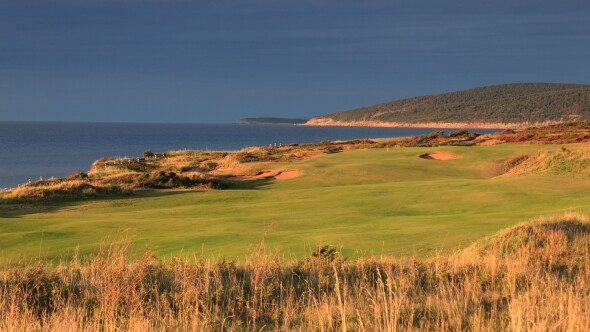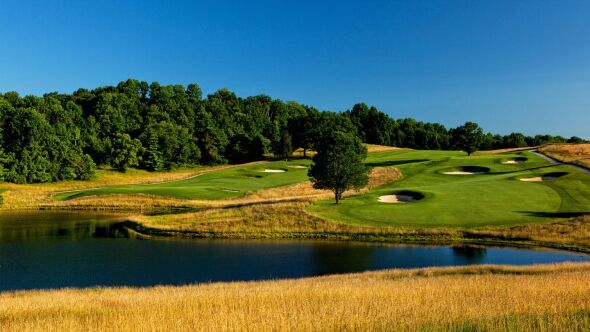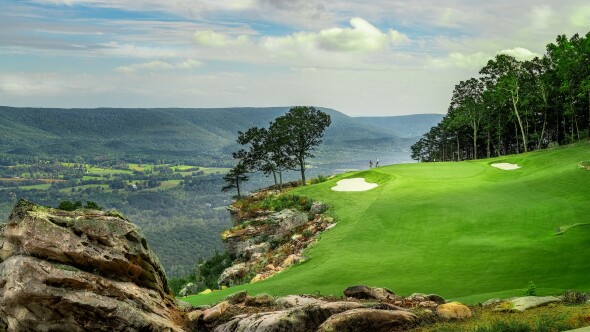I always laugh when I hear about some mid- or even low-handicapper who wants to "play the whole course, all the way back, like the Tour pros do." It’s one of the biggest conceits in golf, because your average golfer, no matter how much they’ve watched the PGA Tour on television or followed the majors, has no real idea how good those guys are: how far they really hit it, how consistently, and with what powers of recovery.
We can glean a statistical sense of that by comparing scoring data of pros and amateurs in tournament competition at the famed Players Stadium Course at TPC Sawgrass. Two things stand out immediately: the scoring; and which holes are harder for which class of players.
The chart below compares hole-by-hole average scoring during the PGA Tour’s Players Championship 2003-2017 versus the results of the 2018 Golf Channel Am Tour's TPC Sawgrass Open, which was staged in January over two days and open to tour members of all handicap levels. (Each flight played one round on the Stadium and one on Dye's Valley.)
It’s not a perfect comparison. Weather, pins and fields all vary. The course was set up much tougher for the pros at an average of 7,215 yards while the amateurs’ distance for the par-72 layout ranged from 6,557 yards (Championship flight: under 4 index) down to 5,976 yards (Snead and Jones flights: 16+ index). The average distance the entire field played was 6,262 yards.
Here’s the surprise: The Tour pros averaged an 18-hole score of 72.69, or just over a half-shot over par per round. Your average amateur notched 98.74 on the Stadium, almost a shot and a half over par per hole. This on a course that averaged close to 1,000 yards shorter than the one hosting The Players.
Another insight: The pros ate up the four par 5s. In terms of relative difficulty, their par 5s were the four lowest holes in average scoring. The amateurs, by contrasts, ran into a lot more trouble on the par 5s, relatively speaking. Their par 5s ranked 2nd-6th-12th-13th in difficulty.
When it came to hitting a 4,200 square foot green surrounded by water with a short-iron in hand, the experience proved overwhelming to the Ams. The average amateur score on the layout’s iconic par-3 17th hole was 5.51.
Mind you, it’s likely that amateurs opting for such an event represent more competitively minded golfers than found on an average tee sheet on any given course. But as any architect can tell you, the difference between average golfers and plus-handicap golfers is greater than ever. That’s reflected in the scoring. And when it comes to testing your nerves, there probably aren’t many courses that come close to this one in spreading the field. Evidence for that can be found among the amateurs themselves: The low-index Championship flight averaged 88.7 while the high-index (20+) Snead flight averaged 116.6. (During the 2012 GC Am Tour National Championship staged in September, the Championship flight averaged 83.86 on the Stadium, while the Snead averaged 113.36.)
There are many take-home lessons here. Playing the back tees in the hopes of playing it like the pros do would be a futile if not absurd (and painfully slow) undertaking. For most golfers, the ball is not going too far. On the contrary, it isn’t going far enough, certainly not with enough regularity and control.
For those who are worried about defending par, I have some advice: watch an average group play an average hole and you’ll see par stands up pretty well. Then, if there’s any doubt, put them on a championship golf course with the kind of deflections, wacky features and looming threat of water found at the Stadium. Makes it all the more impressive what those guys can do with a golf ball. Which is why we should watch them, but not think we can emulate them.
How did your score compare to your handicap when you played TPC Sawgrass? Let us know in the comments below.














LOL. I played this thing some 29 years ago (on my 40th birthday). Don't remember my index, but I was playing pretty well back then. I played great that day, broke 90 (barely) and only rinsed 3 balls. On a bad day? I'd probably would have hit 3 digits! Tough, tough course. There is no fairway on 18, just water.
"I always laugh when I hear about some mid- or even low-handicapper who wants to "play the whole course, all the way back, like the Tour pros do." It’s one of the biggest conceits in golf, because your average golfer, no matter how much they’ve watched the PGA Tour on television or followed the majors, has no real idea how good those guys are"
soooo why not encourage them to play the championship tees and find out? The only thing I hate about golf is this elitest attitude that like you shouldn't even think about doing certain things. If i pay $500 for TPC, I'm not going there to play half the course. I want to shoot a 120+ and see exactly how good the pros are. Isn't that the point?
You are right why pay that money and not play from the back tees even if you are 120 plus
Joe, what exactly does playing from completely inappropriate tees for one's skill set have to do with getting one's money's worth from a round of golf? If anything, by playing the tips when you shouldn't be, you're robbing yourself of that $500 because the sequence of shots you're playing, and clubs you're hitting, is probably completely different than what the pros are hitting. That's why shorter sets of tees exist: to allow non-pros to experience the golf course closer to the way pros do.
Joe, what exactly does playing from completely inappropriate tees for one's skill set have to do with getting one's money's worth from a round of golf? If anything, by playing the tips when you shouldn't be, you're robbing yourself of that $500 because the sequence of shots you're playing, and clubs you're hitting, is probably completely different than what the pros are hitting. That's why shorter sets of tees exist: to allow non-pros to experience the golf course closer to the way pros do.
Joe, what exactly does playing from completely inappropriate tees for one's skill set have to do with getting one's money's worth from a round of golf? If anything, by playing the tips when you shouldn't be, you're robbing yourself of that $500 because the sequence of shots you're playing, and clubs you're hitting, is probably completely different than what the pros are hitting. That's why shorter sets of tees exist: to allow non-pros to experience the golf course closer to the way pros do.
Didn’t play here but played chambers bay before the usga butchered it. I was about a 3 index at the time and had perfect weather. Played from about 1100 yards shorter than the pros played the us open at and shot 94. Unbelievable to think how much harder it would have been from the tips. I hit it pretty long and because of slopes in fairways their would have been numerous par 4s I wouldn’t have been able to reach. Those guys are so much better than the average joe.
I have played the stadium course over 10 times in different times of the year... when we play the am tour event in January,it is always the worst weather.... this year ,it was 41 degrees when we got off the course.... that being said ,the numbers are for 17th get inflated by a few people that struggle with that hole... in my threesome,we had a 3,a15, and a 20...... my advice- NEVER HIT FROM DROP AREA, always te-tee
My wife and I played it in March. She's a 20 handicap and played the forward tees. Needless to say she beat me by a stroke with a 95. My 12.8 index could not withstand the number of penalties. Carded a 5 on 17. Played the Dye course too and it was just as challenging. Absolutely beautiful setting!
Played Sawgrass 20+ Springs ago when I still had a semblance of game. I actually hit the ball well and still shot 100. Played the Valley course after lunch and eased in with an eighty ( mentioned for comparison). Stadium course plays long, tight, and with very few safe outs. I seemed to locate more water than you would imagine watching TV coverage. Toughest course I've played ( Cog # 4 is not to far behind).
Played the course in 1980 before it actually opened. No one on the course that day which was at the end of a one lane dirt road. The delay was because the Tour Players had a fit and said it was too hard. Anyway, it was tough! Green contours and forced carries were much more dramatic on this original version that very few people ever got to see. A herd of goats roamed the native areas. Never forget my first sight of #17. It was like Star Wars Golf as the world had never seen anything like it before. A new era of golf was born.
Playing the Stadium in January is just brutal. Difficult turf, cold and much wind is the norm. The stats of the January vs Sept point that out mostly. Either which way I have to agree though that the Ams have no idea really how good these guys are. Good stuff as usual Brad.
The stats on par 5's I found kind of interesting. I played Cog Hill #4 from the tourney tees last year. I currently carry a 7.7, as low as 3.9 at the end of last year, and shot 90 I was satisfied with. Where I struggled the most, though, was with the longer par 4's. While I can make up distance with a third mid/long iron on par 5's, I just don't have any answers for 460-480 par 4's. They are simply par 5's for me. This has been true of all of the longer courses I've played, so it's interesting to me that the stats seem to say am's have more trouble with the 5's.
Similarly, I've played the island green in Coeur d'Alene a couple times now (and participated in a closest to the pin contest where I hit three more shots) which, I think, is as intimidating as 17. However, ever that wasn't as tough a test, from a golf standpoint, as those long long par 4's.
Other than that, this all makes a lot of sense to me. Those guys are good.
Bogeyed it 2 times, par once double bogey once. This year 1st time in water. Hit drop zone shot to 3 feet then bogey. Senior Snead flight AM Tour.
Hey Rick, no one cares how you played. Especially your wife. She hates you but enjoys spending your money.